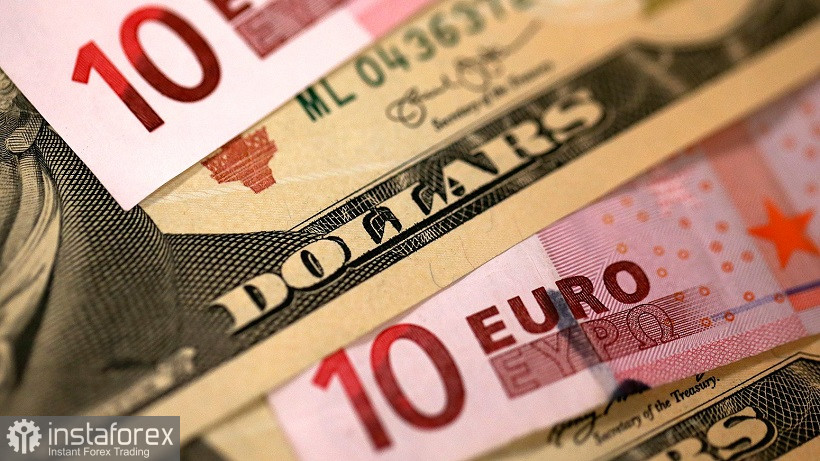The euro-dollar pair is trying to settle below 1.0700 today. Bulls settled in the area of the 7th figure at the end of last week, but failed to test the resistance level of 1.0800 in order to announce the development of a corrective movement. The bears took advantage of this indecisiveness: for the past two days they have been trying to return to the area of the 6th figure in order to repay the growth ambitions of traders. Yesterday this attempt ended in failure. Once the EUR/USD bears crossed 1.0700, the downward momentum began to fade. At the beginning of the US session on Wednesday, traders made another attempt by attacking the support level of 1.0660.

The fundamental background for the pair is controversial. On the side of the EUR/USD bulls are quarantine easing in China, record inflation growth in Germany and the eurozone as a whole, the hawkish mood of the European Central Bank (whose head announced an increase in the rate to zero by September) and relatively good reports from the ZEW and IFO institutions.
But all other fundamental factors play against EUR/USD bulls. The number of anchors that hold back the pair's growth is increasing every day, preventing traders from counting on the development of the upward scenario.
Published last week, the minutes of the Federal Reserve's May meeting outlined the main message: the members of the Committee are ready to implement a flexible scenario for tightening monetary policy. The text of the document states that "a faster rollback of accommodation leaves the Fed in a good position for central banks later this year to assess what further adjustments are needed." This phrase was interpreted against the US currency: according to a number of analysts, after several (most likely two - in June and July) rounds of interest rate hikes, the Fed may take a break to re-evaluate the state of the economy in the context of further actions.
This opinion prevailed last week, putting pressure on the greenback. But this week, one obvious fact emerged, which, in general, always lay on the surface. The fact is that the flexibility in the approach implies an adjustment both towards slowing down the pace of monetary tightening and towards accelerating this process. Therefore, amid recent events, the minutes of the Fed's last meeting, as they say, sparkled with new colors.
Let me remind you that yesterday the EU countries decided to impose a partial embargo on Russian oil, on which the key players in the European Union tried to agree for three weeks. In six months, it will be prohibited to import raw oil through the seaports, and in eight months - refined products. The ban will affect only sea supplies of oil, however, this decision was enough for the prices of Brent and WTI to creep up again. In particular, Brent oil prices on Tuesday reached the highest level in the last three months. In the United States, experts have already warned Americans about a further rise in gasoline prices. In general, rising energy and food prices, as well as disruptions in supply chains, indicate that US inflation is preparing for another rally, although recent releases have indicated the first signs of a slowdown in growth. For example, the April consumer price index came out at around 8.3%. This is somewhat weaker than the March result (8.5%). The core price index for personal consumption expenditures in April also fell from 5.2% in March to 4.9% (in annual terms).
However, taking into account the above circumstances, it can be assumed that the process of slowing down the growth of the main inflationary indicators will be offset. Inflation will again demonstrate active growth, continuing to update multi-year highs. If such assumptions come true, the Fed will be forced to apply its flexible approach already in the context of a more aggressive tightening of monetary policy, and not vice versa. For example, the Fed could raise interest rates by 75 bps in September or/and announce further 50 bps before the end of the year.
These hawkish expectations, which have resumed with renewed vigor, allow the EUR/USD bears to take quite large-scale offensive actions, the purpose of which is to re-conquer the 6th figure.
In my opinion, EUR/USD bulls have missed their chance to develop the upward trend. They came close to the borders of the 8th price level several times, but failed to test this target. As a result, the pair's bulls lost the initiative. Traders consolidated long positions and opened short positions, thereby extinguishing the upward momentum.
Therefore, short positions look more and more attractive. It is advisable to open short positions after the bears overcome the intermediate support level of 1.0660 (the Tenkan-sen line on the daily chart). Downward targets are 1.0590 (middle Bollinger Bands line) and 1.0560 (Kijun-sen line on the same timeframe).
 English
English 
 Русский
Русский Bahasa Indonesia
Bahasa Indonesia Bahasa Malay
Bahasa Malay ไทย
ไทย Español
Español Deutsch
Deutsch Български
Български Français
Français Tiếng Việt
Tiếng Việt 中文
中文 বাংলা
বাংলা हिन्दी
हिन्दी Čeština
Čeština Українська
Українська Română
Română

